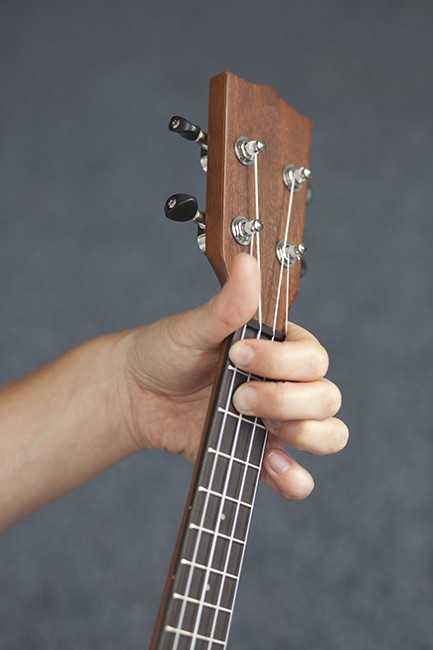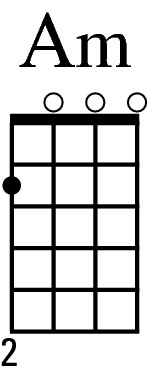Ukulele For Dummies (16 page)
Read Ukulele For Dummies Online
Authors: Alistair Wood

Play E7 with your fingers in the following positions:
 Index finger on the g-string on the first fret.
Index finger on the g-string on the first fret.
 Middle finger on the C-string, second fret.
Middle finger on the C-string, second fret.
 Ring finger on the A-string, second fret.
Ring finger on the A-string, second fret.
 The E-string is open.
The E-string is open.
This chord is a tricky one because of the tendency for your middle finger to catch on the E-string. So double-check that the chord sounds clear. If not, try to arch your middle finger farther over that string by bringing your wrist around a little.
Figure 4-14:
Your fingers look like this when playing E7.

Taking off with your second song: âI'll Fly Away'
You now get to put your new-found seven-chord skills to the test with the song âI'll Fly Away'. The strumming pattern you use for this song is shown in Figure 4-15: down once, and then down-up three times.
Figure 4-15:
The strumming pattern for âI'll Fly Away'.

If you're using the mnemonics, say âFlea Ka-la Ka-la Ka-la'. Strumming notations for the whole song are shown in Figure 4-16, which relates to Track 4.
 Make your chord transitions smoother and quicker by anticipating the next chord. For example, when you play a C chord, your index and middle fingers are free. So you can prepare for the F chord by putting them over the place they have to fret next. In this way they don't have far to move when you change chords.
Make your chord transitions smoother and quicker by anticipating the next chord. For example, when you play a C chord, your index and middle fingers are free. So you can prepare for the F chord by putting them over the place they have to fret next. In this way they don't have far to move when you change chords.
Figure 4-16:
âI'll Fly Away' strum notation.

Practising Minor Chords
Goths are going to love this section because it's dedicated to all the dark, sullen chords.
Minor chords are indicated with a lowercase
âm' after the chord name. So A minor is Am.
Every chord has a minor version: C has C minor (Cm), G7 has G minor 7 (Gm7) and so on. In this section, I talk about three minor chords.
Attempting A minor
A minor is a simple minor chord to start with because it requires just one finger: your middle finger on the g-string at the second fret. So just put your finger on the g-string and strum to create this chord.
Take a look at Figure 4-17 to see the chord diagram and Figure 4-18 for a visual image.
Figure 4-17:
The Am chord diagram.

Moving on to D minor
D minor is very similar to the F chord. Just fret the F chord (as described in the earlier section âFingering an F chord') and add your ring finger on the second fret of the E-string. Take a look at Figures 4-19 and 4-20 for the chord chart and fingering, respectively.
Figure 4-18:
How your fingers look when playing Am.

Figure 4-19:
The D minor chord chart.

 A system does exist to how fingerings are worked out â although it's rather a haphazard one. The default is to fret a note on the first fret with your index finger, second fret with your middle finger and third fret with your ring finger. Following this system usually makes for smoother chord changes. But if you find a better way to fret a chord for a particular change, by all means use it.
A system does exist to how fingerings are worked out â although it's rather a haphazard one. The default is to fret a note on the first fret with your index finger, second fret with your middle finger and third fret with your ring finger. Following this system usually makes for smoother chord changes. But if you find a better way to fret a chord for a particular change, by all means use it.
